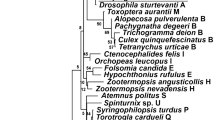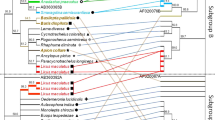Abstract
We studied six species of lice from three of the four suborders of lice. These lice were infected with Wolbachia bacteria from supergroups A and F. This is the first report of an infection of supergroup F Wolbachia in lice. To date, Wolbachia from supergroup F have been found in filarial nematodes, Mansonella spp., and, rarely, in insects. We inferred the phylogeny of the Wolbachia from lice and representatives of all Wolbachia supergroups, with nucleotide sequences from the small subunit ribosomal RNA gene (SSU rRNA). There was no evidence of congruence between the taxon of louse and the Wolbachia bacteria that infect lice. There is no evidence that Wolbachia and their louse hosts co-evolved at least at the level of Wolbachia supergroups. We propose a novel mechanism for the horizontal transfer of Wolbachia between different species of lice from birds: transfer of Wolbachia during phoresis by hippoboscid flies.


Similar content being viewed by others
References
Altschul SF, Madden TL, Schaffer AA, Zhang J, Zhang Z, Miller W, Lipman DJ (1997) Gapped BLAST and PSI-BLAST: a new generation of protein database search programs. Nucleic Acids Res 25:3389–3402
Ballard JW, Dean MD (2001) The mitochondrial genome: mutation, selection and recombination. Curr Opin Genet Dev 11:667–672
Bandi C, Sironi M, Nalepa CA, Corona S, Sacchi L (1997) Phylogenetically distant intracellular symbionts in termites. Parassitologia 39:71–75
Bandi C, Anderson TJC, Genchi C, Blaxter ML (1998) Phylogeny of Wolbachia-like bacteria in filarial nematodes. Proc R Soc Lond B Biol Sci 265:2407–2413
Bandi C, Trees AJ, Brattig NW (2001) Wolbachia in filarial nematodes: evolutionary aspects and implications for the pathogenesis and treatment of filarial diseases. Vet Parasitol 98:215–238
Barker SC (1994) Phylogeny and classifications, origins, and evolution of host associations of lice. Int J Parasitol 24:1285–1291
Baudry E, Bartos J, Emerson K, Whitworth T, Werren JH (2003) Wolbachia and genetic variability in the birdnest blowfly Protocalliphora sialia. Mol Ecol 12:1843–1854
Behura SK, Sahu SC, Mohan M, Nair S (2001) Wolbachia in the Asian rice gall midge, Orseolia oryzae (wood-mason): correlation between host mitotypes and infection status. Insect Mol Biol 10:163–171
Bordenstein S, Rosengaus RB (2005) Discovery of a novel Wolbachia supergroup in Isoptera. Curr Microbiol 51:393–398
Casiraghi M, Bordenstein SR, Baldo L, Lo N, Beninati T, Wernegreen JJ, Werren JH, Bandi C (2005) Phylogeny of Wolbachia pipientis based on gltA, groEL and ftsZ gene sequences: clustering of arthropod and nematode symbionts in the F supergroup, and evidence for further diversity in the Wolbachia tree. Microbiology 151:4015–4022
Clayton DH, Bush SE, Johnson KP (2004) Ecology of congruence: past meets present. Syst Biol 53:165–173
Czarnetzki AB, Tebbe CC (2004) Detection and phylogenetic analysis of Wolbachia in Collembola. Environ Microbiol 6:35–44
Durden LA, Musser GG (1994) The mammalian hosts of the sucking lice (Anoplura) of the world: a host–parasite list. Bull Soc Vector Ecol 19:130–168
Frati F, Negri I, Fanciulli PP, Pellecchia M, De Paola V, Scali V, Dallai R (2004) High levels of genetic differentiation between Wolbachia-infected and non-infected populations of Folsomia candida (Collembola: Isotomidae). Pedobiologia 48:461–468
Girin C, Bouletreau M (1995) Microorganisms-associated variation in host infestation efficiency in a parasitoid wasp Trichogramma bourarachae. Experientia 52:398–402
Hiroki M, Ishii Y, Kato Y (2005) Variation in the prevalence of cytoplasmic incompatibility-inducing Wolbachia in the butterfly Eurema hecabe across the Japanese Archipelago. Evol Ecol Res 7:931–942
Hurst GDD, Jiggins FM, von der Schulenburg JHG, Bertrand D, West SA, Goriacheva II, Zakharov IA, Werren JH, Stouthamer R, Majerus MEN (1999) Male-killing Wolbachia in two species of insect. Proc R Soc Lond B Biol Sci 266:735–740
James AC, Ballard JWO (2000) Expression of cytoplasmic incompatibility in Drosophila simulans and its impact on infection frequencies and distribution of Wolbachia pipientis. Evolution 54:1661–1672
James AC, Dean MD, McMahon ME, Ballard JW (2002) Dynamics of double and single Wolbachia infections in Drosophila simulans from New Caledonia. Heredity 88:182–189
Jeanmougin F, Thompson JD, Gouy M, Higgins DG, Gibson TJ (1998) Multiple sequence alignment with Clustal X. Trends Biochem Sci 23:403–405
Jiggins FM, Hurst GDD, Majerus MEN (1998) Sex ratio distortion in Acraea encedon (Lepidoptera: Nymphalidae) is caused by a male-killing bacterium. Heredity 81:87–91
Keirans JE (1975) Review of phoretic relationship between Mallophaga (Phthiraptera–Insecta) and Hippoboscidae (Diptera–Insecta). J Med Entomol 12:71–76
Kyei-Poku GK, Colwell DD, Coghlin P, Benkel B, Floate KD (2005) On the ubiquity and phylogeny of Wolbachia in lice. Mol Ecol 14:285–294
Lo N, Casiraghi M, Salati E, Bazzocchi C, Bandi C (2002) How many Wolbachia supergroups exist? Mol Biol Evol 19:341–346
Marshall JL (2004) The Allonemobius–Wolbachia host-endosymbiont system: evidence for rapid speciation and against reproductive isolation driven by cytoplasmic incompatibility. Evolution 58:2409–2425
Min KT, Benzer S (1997) Wolbachia, normally a symbiont of Drosophila, can be virulent, causing degeneration and early death. Proc Natl Acad Sci USA 94:10792–10796
Montchamp-Moreau C, Ferveur JF, Jacques M (1991) Geographic distribution and inheritance of three cytoplasmic incompatibility types in Drosophila simulans. Genetics 129:399–407
O’Neill SL, Giordano R, Colbert AME, Karr TL, Robertson HM (1992) 16S rRNA phylogenetic analysis of the bacterial endosymbionts associated with cytoplasmic incompatibility in insects. Proc Natl Acad Sci USA 89:2699–2702
Opijnen T, Baudry E, Baldo L, Bartos J, Werren JH (2005) Genetic variability in the three genomes of Nasonia: nuclear, mitochondrial and Wolbachia. Insect Mol Biol 14:653–663
Perotti MA, Catala SS, Ormeno AD, Zelazowska M, Bilinski SM, Braig HR (2004) The sex ratio distortion in the human head louse is conserved over time. BMC Genet 5:10
Perrot-Minnot MJ, Guo LR, Werren JH (1996) Single and double infections with Wolbachia in the parasitic wasp Nasonia vitripennis: effects on compatibility. Genetics 143:961–972
Price RD, Hellenthal RA, Palma RL, Johnson KP, Clayton DA (2003) The chewing lice: world checklist and biological overview. Illinois Natural History Survey Special Publication 24, Illinois
Rasgon JL, Scott TW (2004) Phylogenetic characterization of Wolbachia symbionts infecting Cimex-lectularius L. and Oeciacus vicarius horvath (Hemiptera: Cimicidae). J Med Entomol 41:1175–1178
Rousset F, Solignac M (1995) Evolution of single and double Wolbachia symbioses during speciation in the Drosophila simulans complex. Proc Natl Acad Sci USA 92:6389–6393
Rousset F, Bouchon D, Pintureau B, Juchault P, Solignac M (1992a) Wolbachia endosymbionts responsible for various alterations of sexuality in arthropods. Proc R Soc Lond B Biol Sci 250:91–98
Rousset F, Vauhin D, Solignac M (1992b) Molecular identification of Wolbachia, the agent of cytoplasmic incompatibility in Drosophila simulans, and variability in relation to host mitochondrial type. Proc Biol Sci 247:163–168
Rowley SM, Raven RJ, McGraw EA (2004) Wolbachia pipientis in Australian spiders. Curr Microbiol 49:208–214
Shoemaker DD, Ross KG, Keller L, Vargo EL, Werren JH (2000) Wolbachia infections in native and introduced populations of fire ants (Solenopsis spp.). Insect Mol Biol 9:661–673
Solignac M, Vautrin D, Rousset F (1994) Widespread occurrence of the proteobacteria Wolbachia and partial cytoplasmic incompatibility in Drosophila melanogaster. CR Acad Sci Paris 317:461–470
Stouthamer R, Breeuwer JAJ, Hurst GDD (1999) Wolbachia pipientis: microbial manipulator of arthropod reproduction. Annu Rev Microbiol 53:71–102
Stouthamer R, Luck RF, Hamiliton WD (1990) Antibiotics cause parthenogenetic Trichogramma to revert to sex. Proc Natl Acad Sci USA 87:2424–2427
Swofford DL (2002) PAUP*. Phylogenetic analysis using parsimony (*and other methods). Sinauer, Sunderland
Telschow A, Hammerstein P, Werren JH (2005) The effect of Wolbachia versus genetic incompatibilities on reinforcement and speciation. Evolution 59:1607–1619
Turelli M, Hoffman AA (1991) Rapid spread of an inherited incompatibility factor in California Drosophila. Nature 353:440–442
Turelli M, Hoffmann AA, McKechnie SW (1992) Dynamics of cytoplasmic incompatibility and mtDNA variation in natural Drosophila simulans populations. Genetics 132:713–723
Vandekerckhove TTM, Watteyne S, Willems A, Swing JG, Mertens J, Gillis M (1999) Phylogenetic analysis of the 16s rDNA of the cytoplasmic bacterium Wolbachia from the novel host Folsomia candida (Hexapoda, Collembola) and its implications for Wolbachial taxonomy. FEMS Microbiol Lett 180:279–286
Werren JH (1997) Biology of Wolbachia. Annu Rev Entomol 42:587–609
Werren JH, Zhang W, Guo LR (1995) Evolution and phylogeny of Wolbachia-reproductive parasites of arthropods. Proc R Soc Lond Ser B Biol Sci 261:55–63
Yen JH, Barr AR (1971) New hypothesis of the cause of cytoplasmic incompatibility in Culex pipiens. Nature 232:657–658
Zhou WG, Rousset F, O’Neill S (1998) Phylogeny and PCR-based classification of Wolbachia strains using wsp gene sequences. Proc R Soc Lond B Biol Sci 265:509–515
Acknowledgements
We thank Peter James for the gift of B. ovis, Maryam Ashrafi (Queensland) and Jan Ford (Tasmania) for collecting the head lice, P. capitis, and Markus Riegler (Queensland) for early discussions on Wolbachia. All experiments comply with the current laws of Australia. The execution of the experiments described in this paper complied with all applicable laws of Australia.
Author information
Authors and Affiliations
Corresponding author
Additional information
An erratum to this article can be found at http://dx.doi.org/10.1007/s00436-006-0452-0
Rights and permissions
About this article
Cite this article
Covacin, C., Barker, S.C. Supergroup F Wolbachia bacteria parasitise lice (Insecta: Phthiraptera). Parasitol Res 100, 479–485 (2007). https://doi.org/10.1007/s00436-006-0309-6
Received:
Accepted:
Published:
Issue Date:
DOI: https://doi.org/10.1007/s00436-006-0309-6




